In this review, we are going to take a look at the Jackery Solar Generator 240, which is made up of the Jackery Portable Power Station Explorer 240 and the Jackery SolarSaga 100 Portable Solar Panel.
If you are one of the many railway enthusiasts that have a collection of video and still camera equipment, you will be well aware of the challenges of keeping everything charged up while you are out and about and also the sinking feeling you get when you pick up the camera to go out, only to realise it is almost flat.
The equipment from Jackery that we are reviewing here could help solve these and many other power-related problems.
Jackery Portable Power Station Explorer 240
The Jackery Portable Power Station Explorer 240 contains a Lithium Battery and provides power to devices in many different ways.
The unit has a 240wh battery, which provides power to devices via USB, 12v and perhaps most useful for camera/photography equipment, a 230v Pure Sine Wave plug socket. Put simply, Pure Sine Wave means it will be compatible with all devices (subject to power requirements of course), some cheaper inverters provide a Modified Sine Wave output, which can be less kind to devices, making them run hotter and potentially wear out quicker.
The Power Station is available from Amazon for £259, although at the time of writing, it is in the summer sale for £194.99 – you can purchase one for yourself by clicking here.
The Power Station weighs around 3kgs, so is not excessively heavy for the power it stores. The device measures 19cm x 13cm x 22cm (approx). The PowerStation is also available in 500W and 1000W outputs (weights and dimensions will increase with size).
So taking a look at the connections in more detail:
- There is a DC input to charge the device, this can be done via the included mains adapter, included car adapter, or the optional Jackery SolarSaga 100W Portable Solar Panel, which we will get onto later.
- There are two USB A ports, providing 5 volts, 2.4amps
- A 12v, 10 amp DC car charging port
- A 230v, 200W Pure Sine-Wave AC UK plug socket.
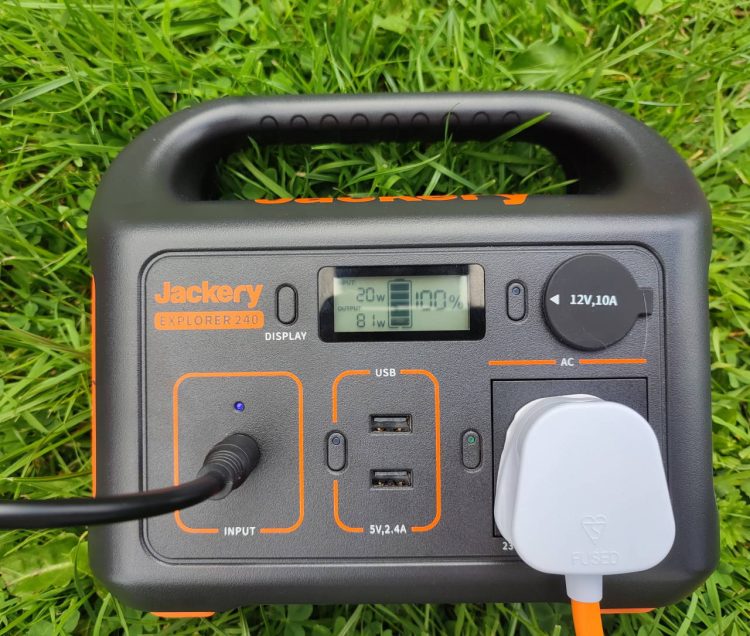
Each port has its own on/off switch, meaning you can have multiple items connected, but not necessarily powered all at the same time.
The supplied charging cables are well made, heavy-duty cables and come in a high-quality pouch.
The back-lit display shows the percentage of battery remaining along with the number of watts of power charging the device and the number of watts of power that the device is providing through the various ports.
If you attempt to plug in a device that uses more than the 200W the unit can provide, it will automatically shut down to avoid damaging itself.
The Jackery Portable Power Station Explorer 240 supports pass-through charging, this is particularly useful when used in conjunction with the Solar Panel as you can be charging the unit and supplying power to devices at the same time.
You may be wondering whether or not this device could be useful for you and your equipment. Many pieces of camera equipment come with a mains adapter to charge the batteries, whilst some of them may support slow USB charging (perhaps from a power bank), not all of them allow you to charge and use the camera at the same time, unless using the mains adapter. In addition, if the camera does not come with a USB or car charger for any spare batteries you may have, then this would be an additional purchase along with any extra spare batteries you may need. Taking these extra accessories into consideration and the cost of these, the Jackery Portable Power Station Explorer 240 suddenly becomes a worthwhile alternative.
Not only could you use this to charge digital cameras, video cameras, mobile phones etc whilst on a trip to a gala, it also could be used for other purposes, for example (subject to device power requirements):
- When camping, to power lights, phones, radios, TVs etc
- Used in conjunction with a 4G router to provide internet on the go (much cheaper than purchasing a dedicated battery-powered router such as the Netgear Nighthawk M2)
- Charging a wheelchair / mobility scooter
- Providing power to a laptop and/or printer where there is no power e.g. a village fete
We tested a few different devices to see how much of the capacity of the power station was used
- Asus 14inch gaming laptop was charged to 50% capacity using 16% of the Jackery’s battery pack.
- A Google Pixel 3A phone was fully charged using 11% of the Jackery
- Watching a Samsung 22inch TV used 14% in one hour
It took around 5 hours to charge from 0 to 100%.
The Jackery Portable Power Station Explorer 240 is available from Amazon by clicking here.
Jackery SolarSaga 100 Portable Solar Panel
The portable SolarSaga 100 Solar Panel could be used as a standalone device but works best in conjunction with the Power Station.
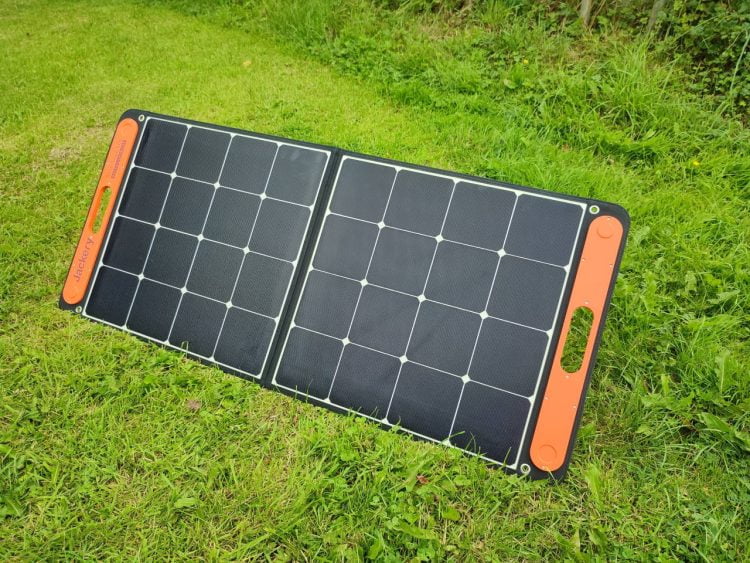
The Solar Panel weighs 4kgs and measures 54cm by 61cm when closed, and 54cm by 123cm when open. It includes two fold away legs so that the panel can be angled in the direction of the sun.
Connectivity options include a cable to run to the Power Station, along with a USB Type A and USB Type C port.
The Jackery SolarSaga 100 Solar Panel is available on Amazon for £259.99 but at the time of writing is available with 5% off. Click here to find out more information.
The panel is IP55 rated, meaning it is water-resistant to splashes, but is not waterproof and therefore could not be left out in all weathers.
Connecting up the Solar Panel to the Power Station is simple enough, just a case of plugging in the cable.
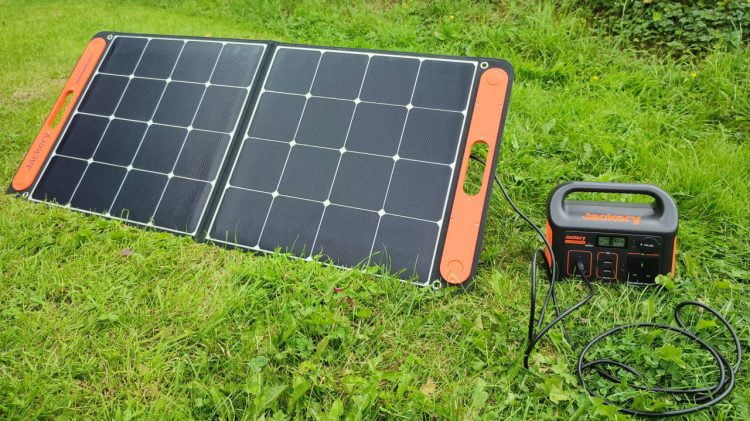
In our tests, the Solar Panel provided 70W of power to the Power Station during sunny weather, though this reduced to around 16W when the sun disappeared behind the clouds.
As mentioned earlier, the solar panel can be used to keep the Power Station topped up whilst the Power Station is itself providing power to devices.
The panel appears to be well made and can be made up / put away very quickly due to the folding design with magnets to ensure the panel stays folded. The cable/ports are hidden away in a zipped up section.
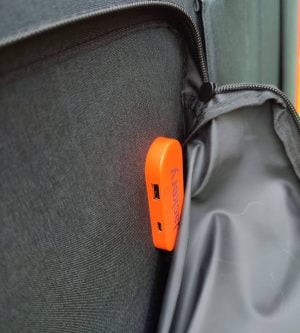
The Jackery SolarSaga 100 Solar Panel is available on Amazon for £259.99 but at the time of writing is available with 5% off. Click here to find out more information.
Conclusion
We found both products worked well together and provide a great alternative power source for almost any device (subject to power requirements).
Whilst the device may initially seem expensive compared to other options, it quickly became clear that this could replace multiple power banks, spare camera batteries and a plethora of car charging cables.
The cost of all those quickly adds up, especially when using official cables and batteries to ensure compatibility.
Coupled with the fact that the Power Station can provide mains power to almost any device, you suddenly realise that it has so many extra uses beyond camera equipment.
The Power Station is highly recommended and hopefully, a future revision could include a USB Type C Power Delivery port for laptops.
The Solar Panel is also a useful addition if you are going to be away from other sources of power for any period of time (for example: perhaps away on a camping holiday)
Amazon Links to all products:
A big thank you to Jackery for sending both the Solar Panel and Power Station Explorer 240 to RailAdvent for us to review.


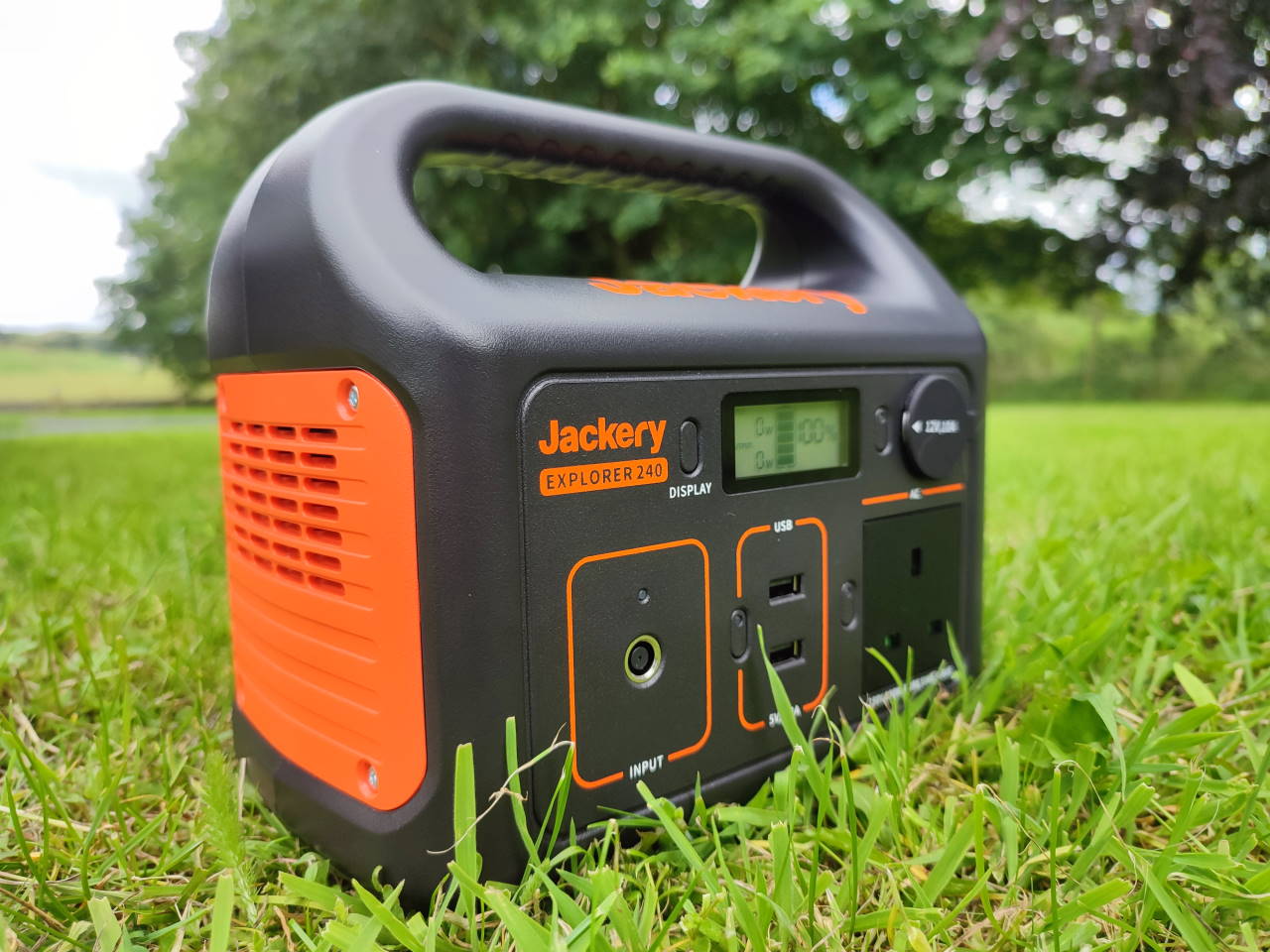



Responses
looks like a really bad product, no USB PD? full charge of a phone using 11%?! not even a variable voltage output like some of the cheaper powerbanks have…
The larger capacity items do have PD charging, just not the 240. For the size of the item, 11% on a phone is quite good in comparison to powerbanks. The main advantage of this over the smaller powerbanks was the option of plugging in a mains charger for a camera/camcorder and taking advantage of those charging options.